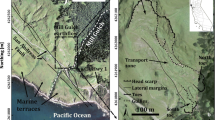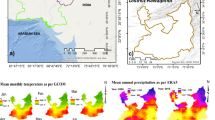Abstract
This study explores the application of interpolating and non-interpolating spatial prediction algorithms to interpreting shear surface geometries. A number of spatial prediction techniques have been tested, and the most appropriate algorithms for the Downie Slide dataset have been selected based on the root mean squared error (RMSE) determined from cross-validation. Visual assessment of reasonable spatial patterns has allowed for final selection of algorithms that produce geologically realistic results. Through this process, the performance of a number of interpolation algorithms has been tested in terms of accuracy and the development of reasonable spatial patterns. The goal of this study has been: (a) to develop a methodology for interpolating three-dimensional shear surface geometries and (b) to assess which interpolation methods are most appropriate for the interpretation of the Downie Slide basal slip surface geometry, based quantitatively on RMSE and qualitatively on the geological “trueness” of the geometric output.







Similar content being viewed by others
References
Aguilar FJ, Agüera F, Aguilar MA, Carvajal F (2005) Effects of terrain morphology, sampling density and interpolation methods on grid DEM accuracy. Photogramm Eng Remote Sensing 71(7):805–816
Base Mapping and Geomatic Services (2003) Canadian digital elevation data, level 1. Government of Canada, Natural Resources Canada, British Columbia Government, Victoria. Centre for Topographic Information, Sherbrooke, Quebec. (www.geobase.ca)
Borga M, Vizzaccaro A (1997) On the interpolation of hydrological variables: formal equivalence of multiquadratic surface fitting and kriging. J Hydrol 195:160–171
Brown R, Psutka J (1978) Revelstoke project, Columbia River Development, Regional Geological Mapping—Interim and Final Reports, 15 pages
Brus D, Gruijter J, Marsam R, Cisschers R, Bregt A, Breeuwsma A (1996) The performance of spatial interpolation methods and choropleth maps to estimate properties at points: a soil survey case study. Environmetrics 7:1–16
Cambardella CA, Karlen DL (1999) Spatial analysis of soil fertility parameters. Percision Agriculture 1:5–14
Carrara A, Bitelli G, Carla R (1997) Comparison of techniques for generating digital terrain models from contour lines. Int J Geogr Inf Sci 11(5):451–473
Cressie NAC (1990) The origins of kriging. Math Geol 22:239–252
Davis BM (1987) Uses and abuses of cross-validation in Geostatistics. Math Geol 19:241–249
Davis JC (2002) Chapter 5: spatial analysis. In: Gerber M (ed) Statistics and data analysis in geology. 3rd edn. Wiley, New York, pp 293–460
Declercq F (1996) Interpolation methods for scattered sample data: accuracy, spatial patterns, processing time. Cartogr Geogr Inf Syst 23(3):128–144
Department of Energy, Mines and Resources (1977) Her Majesty the Queen in right of Canada.
Desmet PJ (1997) Effects of interpolation errors on the analysis of DEMs. Earth Surf Processes Landf 22:563–580
Draper N, Smith H (1981) Applied regression analysis, 2nd edn. In: Bradley RA, Hunter SJ, Kendall DG, Watson GS (eds) Wiley, New York, 709 pp
Golden Software (2002) Chapter 4: creating grid files. Surfer 8 Contouring and 3D surface mapping for scientists and engineers user’s guide. Golden Software, Golden, pp 89–162
Imrie AS, Moore DP, Enegren EG (1991) Performance and maintenance of the drainage system at downie slide. In: Proceedings, Sixth International Symposium on Landslides, Christchurch, New Zealand, pp 751–757
Journel AG, Huijbregts CJ (1978) Mining geostatistics. Academic Press, London 600 pages
Li Z (1988) On the measure of digital terrain model accuracy. Photogramm Rec 12(72):873–877
Laslett GM, McBratney AB, Pahl PJ, Hutchinson MF (1987) Comparison of several spatial prediction methods for soil pH. J Soil Sci 38:325–341
Moore DP, Imrie AS, Enegren EG (1997). Evaluation and management of revelstoke reservoir slopes. In: Commission Internationale Des Grands Barrages, Dix-neuvieme Congres des Grands Barrages, Florence, 22 pp
Piteau DR, Mylrea FH, Brown IG (1978) Chapter 10: downie slide, Columbia River, British Columbia, Canada. In: Voight B (ed) Rockslides and avalanches 1. Elsevier, New York, pp 365–392
Sibson R (1981) A brief description of natural neighbor interpolation. In: Barnett V (ed) Interpreting multivariate data. Wiley, New York, pp 21–36
Smith WHF, Wessel P (1990) Gridding with continuous curvature splines in tension. Geophysics 55(3):293–305
Voltz M, Webster M (1990) A comparison of kriging, cubic splines and classification for predicting soild properies from sample information. J Soil Sci 41:473–490
Weber D, Englund E (1992) Evaluation and comparison of spatial interpolators. Math Geol 24(4):381–391
Weber D, Englund E (1994) Evaluation and comparison of spatial interpolators II. Math Geol 26(5):589–603
Wood J, Fisher P (1993) Assessing interpolation accuracy in elevation models. Comput Graphics Appl 13:48–56
Acknowledgements
This work has been conducted under the financial support of the Natural Sciences and Engineering Research Council of Canada (NSERC), GEOmatics for Informed DEcisions (GEOIDE), and the Provincial Research Excellence Award Program (PREA). The authors would like to thank BC Hydro personnel, in particular John Psutka and Martin Lawrence for provision of the case history data.
Author information
Authors and Affiliations
Corresponding author
Rights and permissions
About this article
Cite this article
Kalenchuk, K.S., Hutchinson, D.J. & Diederichs, M.S. Application of spatial prediction techniques to defining three-dimensional landslide shear surface geometry. Landslides 6, 321–333 (2009). https://doi.org/10.1007/s10346-009-0168-1
Received:
Accepted:
Published:
Issue Date:
DOI: https://doi.org/10.1007/s10346-009-0168-1








